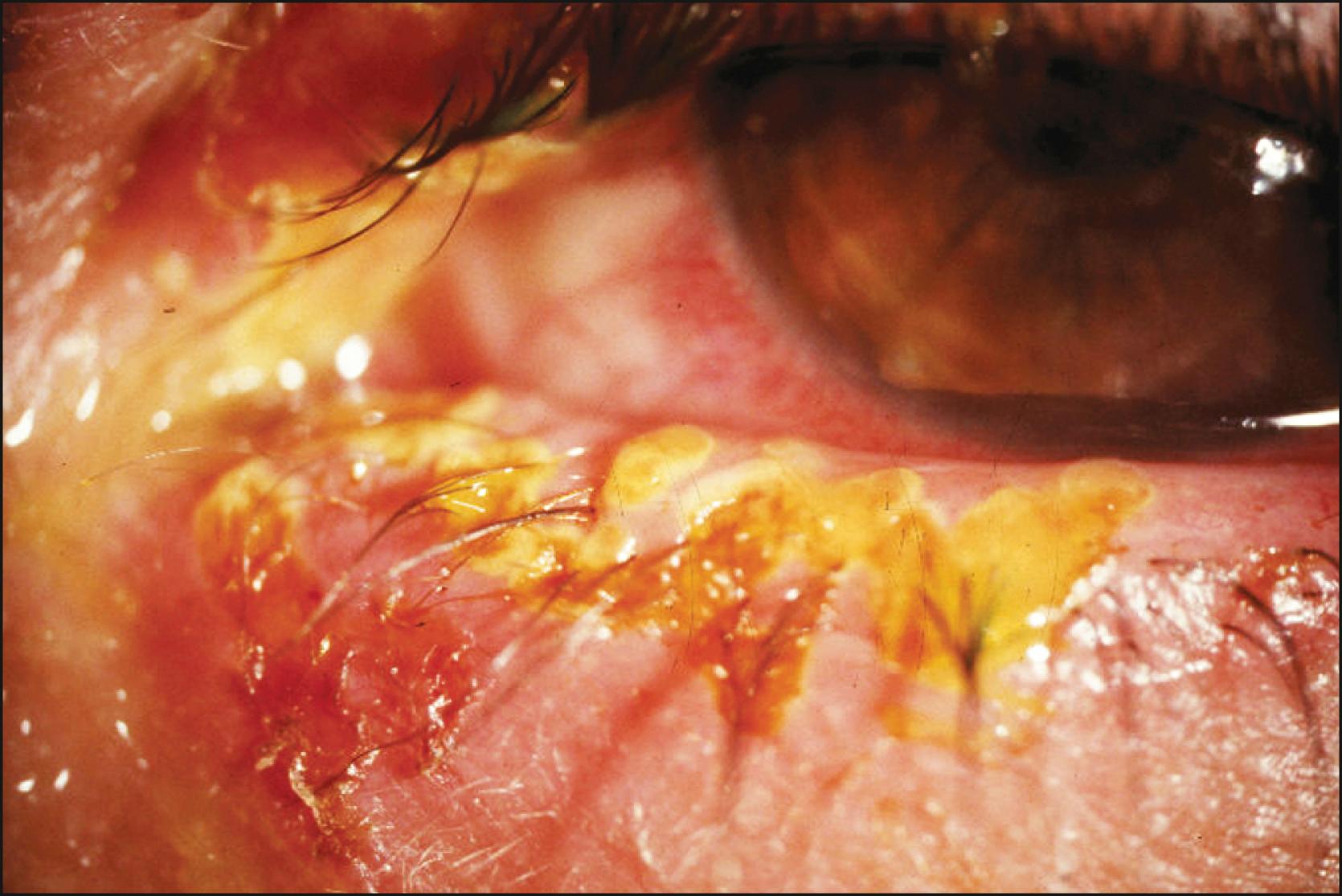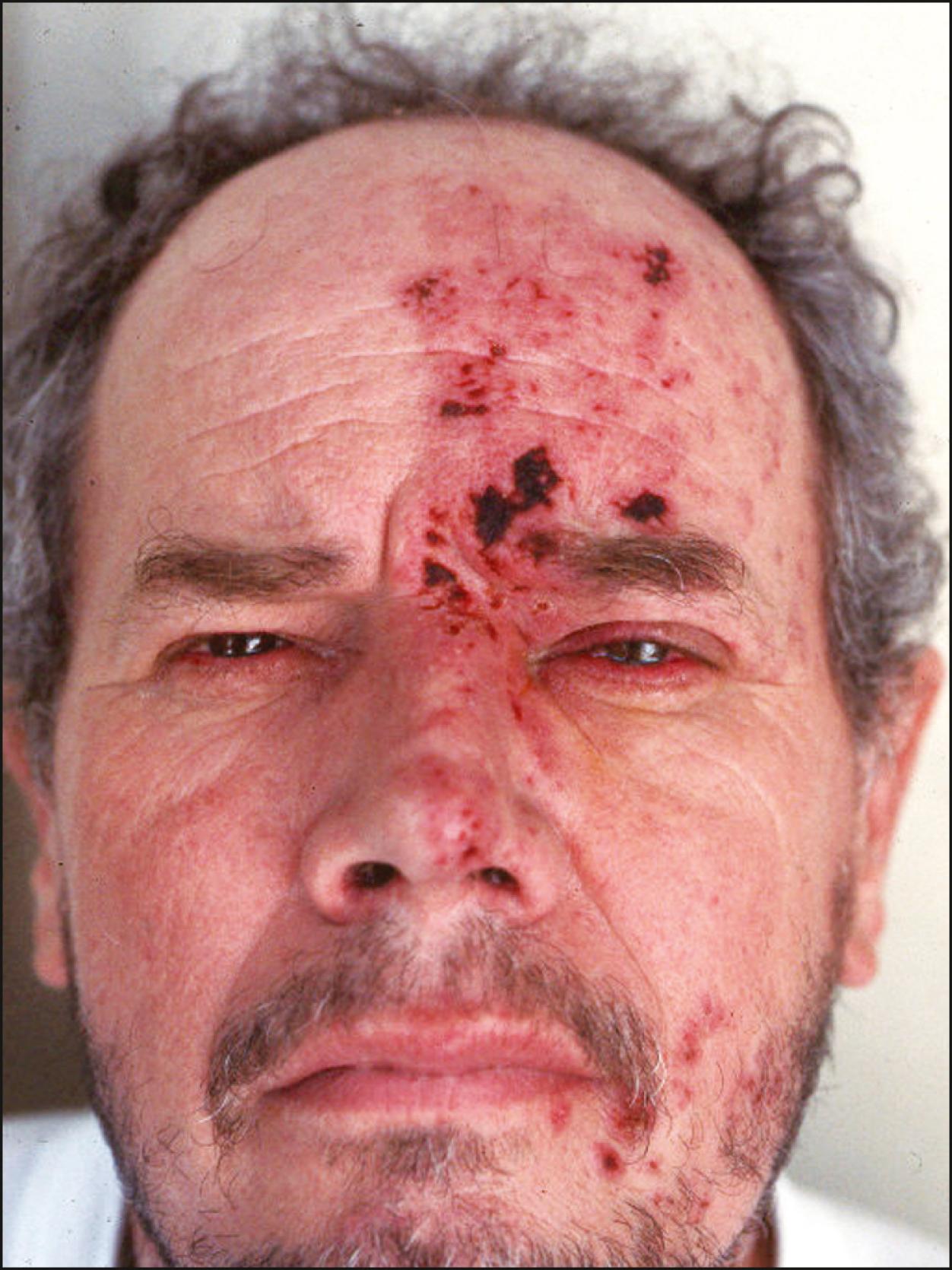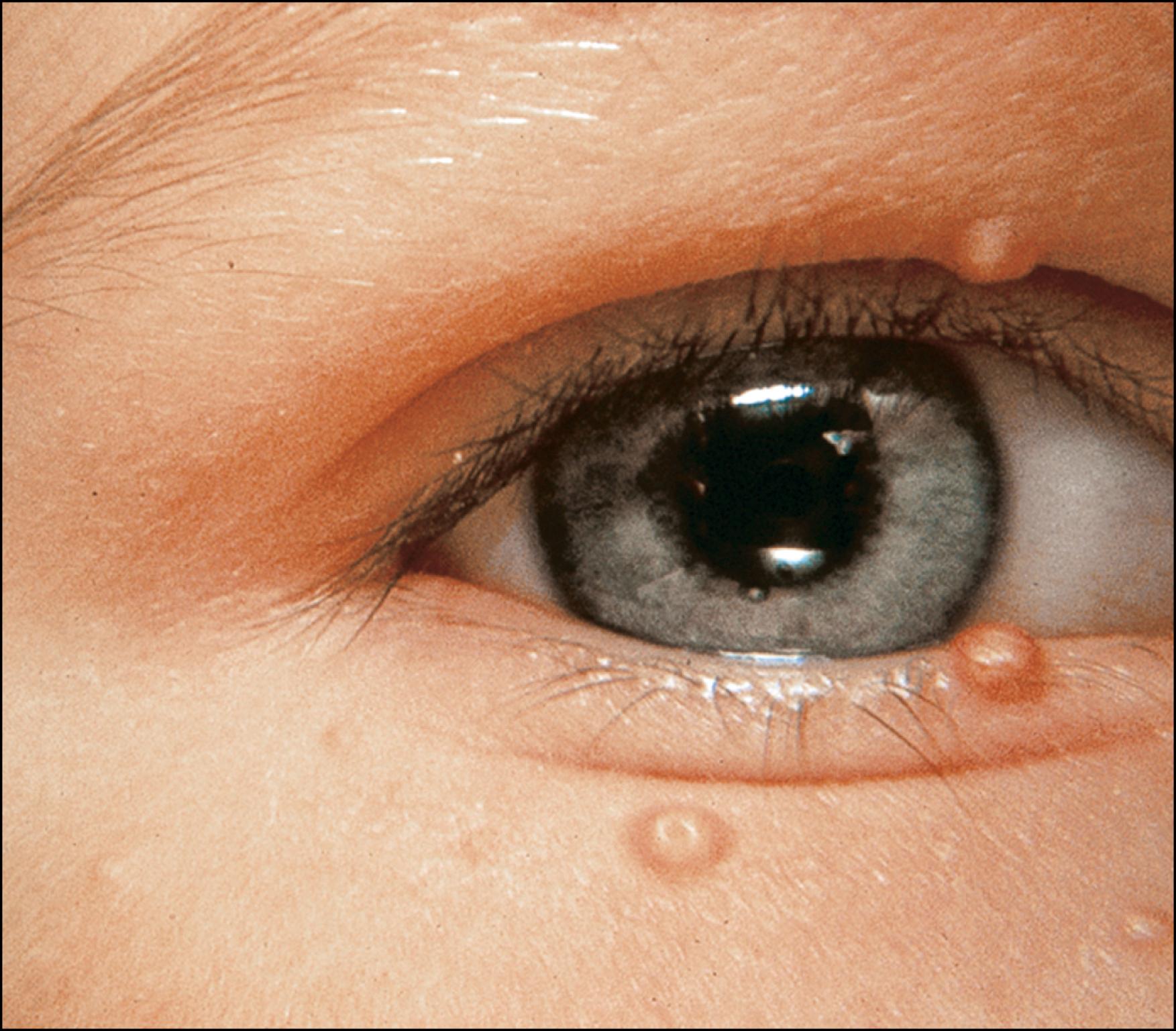Physical Address
304 North Cardinal St.
Dorchester Center, MA 02124
Infections of the periocular skin may herald systemic disease and can spread to the ocular surface.
Patients with cutaneous ocular herpes simplex are at risk for herpetic keratitis.
Herpes zoster infection may lead to lagophthalmos, corneal hypesthesia, neurotrophic keratitis, and vision loss.
The clinician should look for subtle molluscum contagiosum lesions in the presence of chronic unilateral follicular conjunctivitis.
Phthiriasis palpebrarum is transmitted by direct contact.
Bacteria, fungi, viruses, and parasites can cause infection of the eyelids involving different locations (anterior, posterior, angular, etc.) and for different periods of time (acute, intermediate, or chronic).
Herpes simplex virus (HSV) of the eyelids can be a primary or recurrent infection. HSV blepharitis presents as multiple vesicles on a raised, edematous, erythematous base during the first week of infection. In a disease course of 2–3 weeks, lesions pustulate, crust, and heal, leaving no scars unless secondarily infected. In a primary infection, lesions may be more severe, diffuse, and involve the periorbital skin ( Fig. 30.1 ). In recurrent cases, infection tends to be mild and focal unless patients have an accompanying immune disease such as atopy. An ipsilateral preauricular adenopathy is present only in the primary ocular HSV disease. HSV blepharitis is usually diagnosed clinically, but antigen detection or polymerase chain reaction (PCR) can be helpful in difficult cases. Primary ocular HSV infection is a self-limited disease and when limited to the eyelid skin does not necessarily require any specific therapy. Patients with significant primary eyelid HSV infection may benefit from oral acyclovir that may shorten the course of the disease, reduce the chance of corneal involvement, and decrease patient morbidity. In patients with immunologic dysfunction and neonates (<6 weeks of age), HSV may be associated with severe localized disease, systemic dissemination, and herpetic encephalitis with a high morbidity and mortality. , In such patients, systemic antiviral therapy is warranted.

Primary infection with varicella-zoster virus (VZV) presents during childhood as varicella, known more commonly as chickenpox. The virus then remains in a latent form, with reactivation resulting in the development of herpes zoster (HZ) in approximately 20% of infected individuals. However, a live-attenuated VZV vaccine has shown a significant reduction in the incidences of HZ.
The varicella rash usually begins as a crop of small, red papules that develop into clear vesicles on an erythematous base. The vesicles then break and become scabbed. Crops of vesicles continue to appear for 3–4 days, mainly affecting the trunk, face, scalp, and proximal extremities.
Varicella is, in general, a mild ocular disease, and one of the most common associated findings is the vesicular eruption of eyelids and periocular skin that lasts 7–10 days. It seems that there is no association between the severity of varicella rash and the severity of ocular involvement. Skin superinfection is the most frequent complication of varicella. The superinfection may appear on the eyelid area and may cause scarring.
Varicella in healthy children usually resolves itself spontaneously. Skin should be kept clean with frequent baths and showers. Secondary bacterial infection can be treated with topical or systemic antibiotics, depending on the extension and severity of the infection. Patients at an increased risk for severe varicella infection, including those with immunologic dysfunction, should be treated with a systemic antiviral agent.
When the VZV reactivation involves the ophthalmic division, the patient will develop herpes zoster ophthalmicus (HZO). The nasociliary branch innervates the skin of the eyelids, and its involvement causes lid edema with pruritus, hypoesthesia, or pain, followed by a rash. Unlike varicella, HZO may produce cicatricial skin changes.
Early in the course of disease (in the first 2–3 days), patients may develop a painful maculopapular rash, followed by vesicles and then pustules involving the ophthalmic division, complete or incomplete. Sometimes the classical involvement of the tip of the nose (Hutchinson sign) can be observed ( Fig. 30.2 ), indicating involvement of the nasociliary branch and a higher risk of ocular disease. Lesions continue to form over 3–5 days. Active infection usually lasts 7–10 days, followed by crusting of the lesions. Usually one single dermatome is involved, but in severe cases, other adjacent dermatomes can be included. Within 2–3 weeks, dermatitis will slowly resolve itself with crusting of the lesions. Depending on the depth of dermal involvement and the presence of a secondary bacterial infection, vesicle healing varies from leaving just mild skin scars or slight changes in the skin pigmentation to significant scar contracture with eyelid margins deformity and development of trichiasis, ectropion, entropion, or even lagophthalmos. Lagophthalmos can result in severe complications after an HZO infection by causing corneal exposure and surface drying that will inevitably worsen a corneal healing process already compromised by a possibly corneal hypoesthesia also secondary to the HZO. The clinical observation of the characteristic rashes usually leads to the diagnosis of varicella and HZO.

Differential diagnosis includes herpes simplex and bacterial (impetigo) infections or even allergic reactions such as contact dermatitis. Laboratory confirmation of herpes infection may be achieved by the Tzanck smears from the base of a vesicle, in which multinucleated giant cells and intranuclear inclusions confirm the diagnosis. Immunoperoxidase or enzyme-linked immunosorbent assay can detect the viral antigen from vesicle fluid and can differentiate herpes simplex from VZV. PCR seems to be the method of choice for rapid laboratory diagnosis of zoster. Serologic tests can help in cases of primary and acute VZV exposure mainly when acute and convalescent sera are available, but a single serum sample with a high titer of antibody against VZV may suggest a recent exposure.
The US Food and Drug Administration (FDA) has approved three antiviral agents for the treatment of HZ: acyclovir, valacyclovir, and famciclovir. These antiviral agents hasten the resolution of lesions, reduce the formation of new lesions, reduce viral shedding, and decrease the severity of acute pain. Antiviral treatment must be initiated within 72 hours of the onset of the rash, and it is recommended that treatment start as early as possible within this interval. However, many experts recommend that if new skin lesions are still appearing or complications of HZ are present, treatment should be initiated even if the rash began more than 3 days earlier. Treatment is usually given for 7 days in the absence of complications of HZ. Intravenous acyclovir is recommended for immunocompromised persons who require hospitalization and for persons with severe neurologic complications. The use of glucocorticoids with antiviral therapy for uncomplicated HZ remains controversial. , But it may improve performance of activities of daily living and give a reduction in the time to complete healing. Glucocorticoids should not be administered for HZ without concomitant antiviral therapy and should be avoided in patients with hypertension, diabetes mellitus, peptic ulcer disease, and osteoporosis, or particularly in elderly patients, who are at increased risk for serious adverse events. Skin should be kept clean with frequent baths and showers in HZO. Secondary bacterial infection can be treated with topical or systemic antibiotics depending on its extension and severity. Corrective lid surgery following the acute infection may be necessary.
Molluscum contagiosum (MC) is a common self-limiting cutaneous viral infection in healthy children and young adults caused by a poxvirus. In children, lesions are predominantly on the face, head, trunk, and extremities. In young adults, spread occurs primarily through sexual contact with lesions predominantly affecting the genitalia, lower abdomen, and upper thighs. MC in immunosuppressed individuals can be atypical, more severe, and extensive. MC spreads by direct skin-to-skin contact, scratching, and in swimming pools, day care, and shared baths. , The infection affects only the skin and, rarely, the mucous membranes, and it is characterized by small (average of 3–5 mm in diameter), skin-colored, dome-shaped papules, with a waxy, curd-like core. Lesions usually possess an umbilicated center. The eyelid is the most common site of MC ocular lesions ( Fig. 30.3 ). Primary or secondary conjunctival, epibulbar, limbal, and corneal lesions have been also reported, although extremely rare. Follicular conjunctivitis, punctate keratitis, epithelial or subepithelial infiltrates, and corneal pannus can be associated with MC, especially in the eyelid margin, and are due to hypersensitivity or toxicity reaction from the viral proteins shed by the skin lesions. Giant (1.5 cm) lesions have been reported in the literature as having been misdiagnosed as lid tumors in immunocompetent patients and have been misdiagnosed as lid tumors in children. , MC may be overlooked as a cause of chronic unilateral follicular conjunctivitis if eyelid lesions have assumed atypical appearances.

Any chronic follicular conjunctivitis deserves careful search for a MC lesion. Diagnosis in the majority of the cases is clinical, but some challenging cases may require further diagnostic tools. Expressing and smearing the core of a MC lesion on a slide may reveal large intracytoplasmatic inclusions called molluscum bodies. Lesion biopsy can be submitted to either histopathologic studies or PCR methods. Histopathologic analysis usually demonstrates epidermal hyperplasia producing a crater filled with molluscum bodies. Lesions associated with conjunctivitis and/or keratitis require removal with incision and curettage or excision; excision of multiple lid lesions may cause scarring. If the molluscum lesions are not disturbing the conjunctiva and cornea, immunocompetent patients may choose observation over treatment, and lesions usually resolve spontaneously without scarring. In patients with HIV, the lesions may be difficult to eradicate, but clearance of molluscum typically occurs after introduction of antiretroviral therapy. It is important to advise patients to avoid swimming pools, bathing with others, sharing of towels, and activities requiring physical contact with others while there are active lesions.
Transmission of human papillomavirus (HPV) is usually by direct contact or fomites. Removal of eyebrow and facial hair by “threading” has been published as a risk factor for verrucae transmission. , Ocular involvement of the HPV may include the skin of the eyelid, especially its margin in which virus particles may be shed into the tear film resulting in toxic or hypersensitive subacute papillary conjunctivitis. These patients often experience foreign body sensation and photophobia. A punctate epithelial keratopathy also may occur with or without conjunctivitis. If untreated, chronic inflammation may lead to the development of peripheral corneal neovascularization. Eyelid lesions may be pedunculated or broad based, and are often multilobulated. They consist of finger-like projections of papillary dermis covered with epidermis with the same color as the adjacent skin, slightly erythematous, or pigmented. Lesions are usually painless, keratinized, and papillomatous. They must be differentiated from actinic keratosis, seborrheic keratosis, basal cell epithelioma, keratoacanthoma, and squamous cell carcinoma. HPV type 16 may be important in the pathogenesis of malignant squamous neoplasms of the conjunctiva, cornea, and eyelid. Oral cimetidine, topical interferon or mitomycin, and excision and intraoperative application of mitomycin C (MMC) have been reported as alternative therapy for recurrent lesions. ,
Bacterial infections of the eyelid represent a heterogeneous group of disorders ranging from innocuous, self-limiting lesions to life-threatening infections. The infection may be limited to the eyelid or be a local manifestation of a diffuse cutaneous or multisystemic infection.
Hordeolum is a common, acute, painful, suppurative, nodular inflammatory lesion of the eyelid usually caused by bacterial infection ( Staphylococcus species). The infection may affect the glands of Zeis, Moll, or hair follicles (external hordeolum, also known as stye) or the meibomian glands (internal hordeolum). Hordeolum is often associated with blepharitis and can be multiple and recurrent. Sterile acute inflammation from obstructed and ruptured meibomian glands with extravasation of glandular contents into the eyelid interstitial space can mimic an infectious process (“acute chalazion”). Eventually, the infection can spread to other glands, becoming long lasting. If unresolved, acute internal hordeolum can become chronic or can develop into a chalazion. Laboratory evaluation with culture is not necessary for uncomplicated cases. The natural history of acute internal hordeolum generally spans 1–2 weeks, beginning with the appearance of an abscess and concluding with spontaneous draining of the abscess. Warm compress and lid massage and scrubs may accelerate the healing process. A topical antibiotic is usually not effective. If the condition is severe, systemic antibiotics or surgical incision and drainage may be implemented. Incision and drainage are also reserved for persistent, large, internally bothersome pointing lesions. Treatment of the associated blepharitis may decrease the recurrence rate.
Preseptal and orbital cellulitis are two acute infectious diseases with a potential morbidity and mortality. Preseptal cellulitis (more common) refers to infections localized anterior to the orbital septum; postseptal cellulitis is used when the infectious process is located or has extended posterior to the orbital septum with involvement of the globe. Preseptal cellulitis occurs mostly in the pediatric population, and the major risk factors are direct inoculation as a result of trauma, insect bites, or any local infections (e.g., dacryocystitis or hordeolum), and spread from facial skin infections such as impetigo and erysipelas; it can also occur from extension of infection from the paranasal sinuses, upper respiratory tract, and middle ear.
Disease begins with an acute onset of unilateral eyelid inflammation with pain, redness, swelling, and warmth erythema that can be accompanied by fever and malaise. It is extremely important to differentiate preseptal from orbital cellulitis as the latter has the potential for central nervous system involvement, including cavernous sinus thrombosis, meningitis, abscesses, and death. In orbital cellulitis, we observe significant conjunctival hyperemia and chemosis, proptosis, decrease of visual acuity, decreased ocular motility, and changes in pupil light reactions.
The main pathogens involved in posttraumatic preseptal cellulitis are Staphylococcus aureus and Streptococcus pyogenes . Preseptal cellulitis without trauma or facial infections is almost exclusively due to Haemophilus influenzae and Streptococcus pneumoniae and usually begins with a mild upper respiratory tract infection. In these cases, children should be considered for hospitalization because of the rapid progression to orbital cellulitis. Universal vaccination against H. influenzae led to a marked decrease of infections with this microorganism. Fungal orbital infections invade the orbit via the paranasal sinuses and occur mostly in the immunocompromised host (mucormycosis).
The diagnosis of preseptal cellulitis is primarily clinical, but patients may need the mean white blood cell count, the erythrocyte sedimentation rate, and the C-reactive protein levels checked, and those are usually significantly higher among patients with orbital cellulitis as compared with those with periorbital cellulitis. Computed tomography should be performed if the globe cannot be adequately assessed clinically or if penetration of the orbital septum is suspected. A subperiosteal abscess can be present with no other signs of orbital disease. Culture of samples of conjunctival discharge, eyelid lesions, and lacrimal sac material, if possible, should be sent to microbiology to help in guiding the therapy.
Management of preseptal cellulitis includes appropriate antibiotic therapy, which should be promptly initiated and modified based on clinical response and interpretation of sample culture and sensitivity results. The selection of antibiotics is directed to the most likely causative agents. The majority of children with nonsevere preseptal cellulitis can be managed as outpatients with oral antibiotics. Children highly febrile, with toxic appearing and/or having neutrophilic leukocytosis should have parenteral antibiotics. Complicated cases may eventually require surgical drainage or debridement. Visual dysfunction may also result in children with prolonged eyelid edema secondary to occlusion amblyopia.
Become a Clinical Tree membership for Full access and enjoy Unlimited articles
If you are a member. Log in here